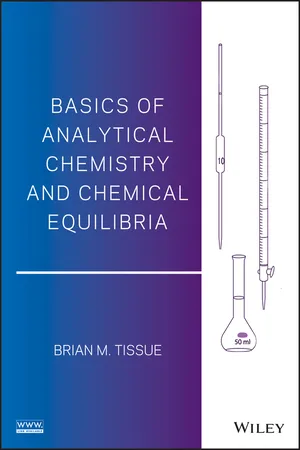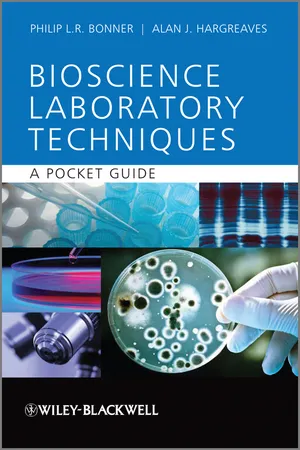Chemistry
Buffers Preparation
Buffers preparation involves creating a solution that resists changes in pH when an acid or base is added. This is typically achieved by mixing a weak acid and its conjugate base, or a weak base and its conjugate acid, in specific proportions. The resulting buffer solution is important in various chemical and biological processes, as it helps maintain a stable pH environment.
Written by Perlego with AI-assistance
Related key terms
Related key terms
1 of 4
Related key terms
1 of 3
10 Key excerpts on "Buffers Preparation"
- No longer available |Learn more
- Brian M. Tissue(Author)
- 2013(Publication Date)
- Wiley(Publisher)
Chapter 6: Buffer Solutions and Polyprotic Acids
Learning Outcomes- Identify buffer solutions and predict p[ ] using the Henderson–Hasselbalch equation.
- Use alpha fraction plots to predict the dominant form of a weak acid as a function of pH.
- Describe the regions of a weak acid titration curve and calculate analyte concentration.
- Identify polyprotic acids and determine the limiting reagent in neutralization reactions.
- Predict p[ ] for different forms of a polyprotic weak acid.
6.1 Buffer Solutions
A buffer in chemistry is anything that counteracts a change to a chemical system. A buffer will be added to a test portion to control one or more aspects of the solution chemistry that might affect a measurement. In redox chemistry, a “redox buffer” can maintain one or more species in a certain oxidation state. Analytical methods for iron will often use a reducing agent, for example, hydroxylamine in the Fe-phenanthroline practice exercise in Chapter 4, as a reagent to retain the iron in the Fe form. A pH buffer is a solution that can maintain a nearly constant pH when diluted or when a small amount of strong acid or strong base is added. A buffer solution consists of a mixture of a weak acid and its conjugate base. Describing a buffer as a weak base and its conjugate acid is equivalent. As many analytes and reagents have acidic or basic groups, acid–base buffers are common in analytical applications to control the solution chemistry. You will see from the examples in the chapter that buffer systems also exist in many environmental and biological systems.How can we make a pH buffer? There are several ways to produce a mixture of a weak acid and its conjugate base:- Mix a weak acid and a salt of its conjugate base in solution.
- Mix a weak acid and enough strong base to neutralize some of the weak acid.
- Mix a weak base and enough strong acid to neutralize some of the weak base.
Any of these procedures will result in a solution that contains a weak acid and its conjugate base. The last two cases are limiting reagent calculations, with the strong base or strong acid being the limiting reagent. Adding excess strong base to a weak acid, or excess strong acid to a weak base, will not produce buffer solutions. The pH response of a buffer solution is illustrated in the following examples. - eBook - ePub
- Clyde Frank(Author)
- 2012(Publication Date)
- Academic Press(Publisher)
Buffered solutions are of great significance. For example, many physiological processes require a fixed pH to function properly. Often the permissable pH range is very narrow. To maintain this pH, nature has included buffers into the system, and, frequently, the components of these buffers are the same ones that the chemist uses in the laboratory. Thus, if these same processes are to be studied in the laboratory, the conditions for the buffer must be clearly understood.The control of pH in experimental chemistry is essential in all sorts of chemical and instrumental applications. Often the success in these applications will be determined by how carefully the pH is controlled and maintained.The most common type of buffer solution is made by dissolving a weak acid and a salt of the same weak acid in water or by dissolving a weak base and a salt of the same weak base in water. For example, consider the first case where ionization will occur according to the reaction(8-32)If a salt of the weak acid, NaA, is added, the H3 O+ concentration will decrease (pH increases) as predicted by the Le Chatelier principle; that is, the equilibrium is shifted to the left.If a strong acid or some other source of hydronium ion is introduced into the solution, association with the anion A− , reverse of reaction (8-32), takes place. Since there is a large reservoir of A− little change in pH is observed.If a strong base or hydroxide ion is introduced into the solution, neutralization of the hydronium ion in reaction (8-32) occurs. To replace the consumed hydronium ion more HA is ionized and since there is a reservoir of HA the pH changes only slightly.A buffer made from a weak base (BOH) and its salt (BX) can be described in an analogous way. In this case ionization of the weak base must be considered.(8-33)As hydronium ions are added, they are neutralized by the hydroxide ion which are replaced by more ionization of BOH. If hydroxide ions are added, they are consumed by reaction with B+ - No longer available |Learn more
Basic Bioscience Laboratory Techniques
A Pocket Guide
- Philip L.R. Bonner, Alan J. Hargreaves(Authors)
- 2011(Publication Date)
- Wiley(Publisher)
Table 1.2 ) the proton on the carboxyl group of acetic acid can dissociate and go into solution. This leaves a negatively charged acetic acid and a positively charged proton in solution.1.7 BuffersFigure 1.7 A titration curve for acetate buffer.Many biological compounds have weak acidic groups present within their structure. As a result, the surface charge on the molecule will vary according to the surrounding pH. Amino acids, proteins, nucleotides and nucleic acids have weak acidic groups as part of their structures and the degree of ionization of these molecules is pH dependent. As the integrity and functionality of these molecules depends on the pH, maintaining this optimum pH value is extremely important in biology.1.7.1 Preparing a Buffer and Using a pH MeterThere are many different buffers used in bioscience laboratories to preserve the pH of a solution (some listed in Table 1.3 ). A buffer comprises of a weak acid and one of its salts (conjugate base) or a weak base and one of its salts (conjugate acid). Buffers work best when there is a balance between charged and uncharged species (pKa) (see Figure 1.7 and section 1.8). At the pKa buffers are able to absorb changes in the concentration of [H+ ] protons or hydroxyl groups [OH– ] without significantly altering the overall pH. There is a limit to this buffering capacity which is approximately 1.0 pH unit either side of the buffer’s pKa. If the desired pH value is at the extremes of the buffer’s pKa value, the molarity of the buffer should be increased or a different buffer used.Table 1.3 A list of common buffers and their effective pH rangeBuffer pKa Effective buffer range Maleate 1.97 1.2–2.6 Acetate/CH3 COOH 4.76 3.6–5.6 MES 6.10 5.5–6.7 PIPES 6.76 6.1–7.5 NaH2 POVNa2 HPO4 7.20 5.8–8.0 HEPES 7.48 6.8–8.2 Tricine 8.05 7.4–8.8 Tris/HCl 8.06 7.5–9.0 Na2 CO3 /NaHCO3 10.33 9.0–10.7 - When the desired molarity of the buffer has been decided, the buffer is weighed out and dissolved (see Section 1.4) in a volume of water (highest purity available) less than the final volume required. Any additions to the buffer which may contribute to the pH value (e.g. EDTA) should be dissolved at this stage before the pH is finalized. When the buffer has dissolved, the pH can be adjusted using a pH meter (see Figure 1.8
- eBook - ePub
- Professor Rob Beynon, J Easterby(Authors)
- 2004(Publication Date)
- Taylor & Francis(Publisher)
5 Preparation of buffer solutions• Using written recipes• Design of new buffers• Practical considerations• Describing buffers1. Where do I start?Armed with a new understanding of buffer theory, you will, sooner or later, need to prepare a buffer for pH control. But how do you decide which buffer to prepare? Often, you will be able to follow specifications as presented to you in a laboratory manual or scientific paper. Beware— sometimes these recipes are incomplete or misleading. You will need your newly won capability to interpret these incomplete recipes, just as much as if you had to make the buffer from first principles. There will be times when you will need to design your buffer system from scratch. For example, you may need to design a new buffer for a chromatographic separation, determine the pH optimum of a system, or assess buffer-specific effects in a new procedure. In this chapter, we will discuss the practicalities of buffer preparation, and show how the rather abstract theory of the previous chapter really does influence ‘wet’ laboratory procedures.2. Following existing recipesIn scientific papers or published protocols, you will read descriptions of buffers. In most instances, the description will (we hope) be complete and precise, and you will have no difficulties in making up such a buffer. Be forewarned, however, that there is usually more than one procedure that you can follow to make a buffer and you may have to choose the one that yields the same buffer as the original authors intended.◊ This can require skills in mindreading in some cases!Sometimes the published description will be vague. The scientific literature, and other people’s notebooks are littered with ‘shorthand’ descriptions such as ‘0.1 M acetate, pH 5.0’, ‘0.05M Tris/acetate’, or, even worse, ‘2X Buffer A’—you will probably succeed in part if you attempt to prepare the first example, have difficulty with the second, and should not even attempt the last of these! - eBook - ePub
Chemistry
Concepts and Problems, A Self-Teaching Guide
- Richard Post, Chad Snyder, Clifford C. Houk(Authors)
- 2020(Publication Date)
- Jossey-Bass(Publisher)
+ concentration), creating a greater than normal acidity. Electrolyte balance inside and outside the cells of our body is also pH dependent. To maintain the proper balance requires a carefully regulated system wherein the pH of the system remains virtually constant within very specific limits. We now discuss this system that is so prevalent in our bodies and that is extensively used in commercial processes to maintain a constant pH.BUFFER SOLUTIONS
When chemists wish to keep the pH of a solution fairly constant even if some small amount of strong acid or base is added, they will use a buffer solution. A buffer solution involves a chemical equilibrium between either a weak acid and its salt or a weak base and its salt, and shows the common ion effect.A typical buffer solution is one made up of acetic acid (HC2 H3 O2), which dissociates to a small degree into H+ and ions, and sodium acetate, a salt of acetic acid that dissociates completely into Na+ and ions. Which ion is common to acetic acid and sodium acetate? __________Answer: , the acetate ionA buffer solution can consist of a weak acid and its salt or a weak base and its salt, depending upon the desired pH of the buffer solution. A buffer solution with a pH in the acidic range (1 – 7) can be made from a solution of a weak acid and its salt. A buffer solution with a pH in the basic range (7–14) can be made from a solution of a weak base and its salt. HC2 H3 O2 and its salt NaC2 H3 O2 are useful for making a buffer solution with a pH in the _________ range.Answer: acidic (HC2 H3 O2 is a weak acid.)The key to understanding the action of a buffer solution is to remember that a weak acid (or weak base) is only dissociated to a very small degree. Most of the HC2 H3 O2 is still in molecular form when in aqueous solution. The salt, in contrast, is completely dissociated. All of the NaC2 H3 O2 becomes Na+ and - eBook - ePub
Laboratory Manual for Biotechnology and Laboratory Science
The Basics, Revised Edition
- Lisa A. Seidman, Mary Ellen Kraus, Diana Lietzke Brandner, Jeanette Mowery(Authors)
- 2022(Publication Date)
- CRC Press(Publisher)
A. Working with Buffers
The purpose of buffers is to maintain a solution at the proper pH. You will work with two commonly used buffers: Tris and phosphate. Tris [tris(hydroxymethyl)aminomethane] is commonly used because it buffers over the normal biological range (pH 7 to pH 9), is nontoxic to cells, and is relatively inexpensive. Tris is supplied as a crystalline solid. Tris that is not conjugated to any other chemical is called “Tris base.” Tris base has a FW of 121.1 and a pKa of 8.0, which means that it has the greatest capacity to buffer a solution at a pH of around 8.A 1 M solution of Tris can be prepared by dissolving 121.1 g of Tris base in 1 liter of water. However, the pH of such a solution will be more than 10. This pH is far from the pKa for Tris, and the solution will have little buffering capacity. Moreover, few biological systems function at such a high pH. Therefore, before the Tris solution is useful as a biological buffer, its pH must be lowered. There are several strategies to obtain a buffer that has both the correct pH and the correct concentration. The two strategies that we will use in this exercise are as follows:- Strategy 1 . The buffer is titrated with a strong acid or base.
- The buffer is dissolved in water, but it is not brought to its final volume. If the pH of the solution is lower than the desired pH, then a strong base (often NaOH) is added to raise the pH. If the pH of the solution is above the desired pH, then a strong acid (often HCl) is added to lower the pH. There are situations where the sodium from NaOH or the chloride from HCl interferes with the system of interest. In such cases, other acids or bases are substituted. Once the desired pH is reached, the solution is brought to its final volume.
- eBook - ePub
- John Kenkel(Author)
- 2020(Publication Date)
- CRC Press(Publisher)
0. 500 mL of the 100 ppm solution would be measured into a 500 mL flask and diluted to volume.3.7 BUFFER SOLUTIONS
Buffer solutions, or solutions which resist changes in pH even when a strong acid or base is added, are almost always composed of a weak acid or weak base and the salt of this weak acid or base. The reason for the resistance to pH change is that the weak acid or weak base ionization equilibrium shifts in these solutions such that the H+ or OH− added are consumed, thus resulting in no net pH change.Although commercially prepared buffer solutions are available, these are most often utilized solely for pH meter calibration and not for adjusting or maintaining a chemical reaction system at a given pH. It is not surprising, therefore, that the analyst often needs to prepare his/her own solutions for this purpose. It then becomes a question of what proportions of the acid, or base, and its salt should be mixed to give the desired pH.The answer is in the expression for the ionization constant, Ka or Kb , where the ratio of the salt concentration to the acid concentration is found. In the case of a weak acid,HA ⇌H +A −(3.33)
and in the case of a weak base,K a=[H +][A −][ HA ](3.34) B+H 2O ⇌BH ++OH −(3.35) K b=[BH +][OH −][ B ](3.36) Knowing the value of Ka or Kb , for a given weak acid or base and knowing the desired pH value, one can calculate the ratio of salt concentration to acid (or base) concentration that will produce the given pH. Rearranging Equation 3.34, for example, would show the method for calculating this ratio in the case of a weak acid and its salt.=K a[H +][A −][ HA ](3.37) This is one form of the Henderson-Hasselbalch equation for dealing with buffer solutions. It says that one would simply divide the Ka by the [H+ ] to obtain the required ratio. It should be stressed that since the Ka , or Kb , enters into the calculation, how weak the acid or base is dictates what is a workable pH range for that acid or base. Table 3.3 - eBook - ePub
- Linda Costanzo(Author)
- 2021(Publication Date)
- Elsevier(Publisher)
− form.The body fluids contain a large variety of buffers, which constitute an important first defense against changes in pH. Robert Pitts demonstrated this buffering capacity experimentally by injecting 150 mEq of H+ (as hydrochloric acid, HCl) into a dog whose total body water was 11.4 L. In a parallel experiment, Pitts added 150 mEq of H+ to 11.4 L of distilled water. In the dog, the addition of H+ caused the blood pH to decrease from 7.44 to 7.14—the dog was acidemic but alive. In the distilled water, addition of the same amount of H+ caused the pH to drop precipitously to 1.84, a value that would have been instantly fatal to the dog. Pitts concluded that the dog’s body fluids contained buffers that protected its pH from the addition of large amounts of H+ . The added H+ combined with the A− form of these buffers, and a strong acid was converted to a weak acid. The decrease in the dog’s body fluid pH was minimized, although not totally prevented. The distilled water contained no buffers and had no such protective mechanisms.Henderson-Hasselbalch equation
The Henderson-Hasselbalch equation is used to calculate the pH of a buffered solution. This equation is derived from the behavior of weak acids (and bases) in solution, which is described by the kinetics of reversible reactions:HA⇄K 2K 1H ++A −The forward reaction, the dissociation of HA into H+ and A− , is characterized by a rate constant, K1 , and the reverse reaction is characterized by a rate constant, K2 . When the rates of the forward and reverse reactions are exactly equal, there is a state of chemical equilibrium, in which there is no further net change in the concentration of HA or A− . As shown here, the law of mass action - eBook - ePub
- Peter Kam, Ian Power(Authors)
- 2015(Publication Date)
- CRC Press(Publisher)
K) of the substance.P H SYSTEMH+ ion concentration may be measured in two ways: directly as concentrations in nanomoles per litre or indirectly as pH. pH is defined as the negative logarithm (to the base 10) of the concentration of hydrogen ions. The pH is related to the concentration of H+ as follows:pH = log101[H +]pH = log10[H +]H +=10− pHpH = p K + log base/acidTable 8.1 Relationship between pH and hydrogen ion concentrationpH Hydrogen ion concentration (nmol/L) 7.7 20 7.4 40 7.3 50 7.1 80 It is important to note that pH and hydrogen ion concentration [H+ ] are inversely related such that an increase in pH describes a decrease in [H+ ] (Table 8.1 ). However, the logarithmic scale is nonlinear and, therefore, a change of one pH unit reflects a 10-fold change in [H+ ] and equal changes in pH are not correlated with equal changes in [H+ ]. For example, a change of pH from 7.4 to 7.0 (40 nmol/L [H+ ] to 100 nmol/L [H+ ]) represents a change of 60 nmol/L [H+ ], although the same pH change of 0.4, but from 7.4 to 7.8 (40 nmol/L [H+ ] to 16 nmol/L [H+ ]), represents a change of only 24 nmol/L [H+ ].BUFFERSA buffer is a solution consisting of a weak acid and its conjugate base, which resists a change in pH when a stronger acid or base is added, thereby minimizing a change in pH. The most important buffer pair in extracellular fluid (ECF) is carbonic acid (H2 CO3 ) and bicarbonate (HYDROGEN ION BALANCEHCO 3 −). The interaction between this buffer pair forms the basis of the measurement of acid–base balance.Cellular hydrogen ion turnover can be described in terms of processes that produce or consume H+ ions in the body (Table 8.2 ). The total daily H+ - eBook - ePub
- Camillo Peracchia, Nasr H. Anaizi(Authors)
- 0(Publication Date)
- Bentham Science Publishers(Publisher)
Ideally, the pK a of this buffer system should be equal or close to the desired pH of the solution. The addition of 100 mEqs of HCl to one liter of water containing 200 mEqs of acetate ion causes conversion of about half the acetate to acetic acid, thereby neutralizing much of the added H + ion and minimizing Δ[H + ] (i.e., buffering the pH). In a buffer system composed of HA and A -, the un-dissociated acid (HA) protects the pH of the solution against the addition of bases (or OH -) while the conjugated base (A -) guards against the addition of acid (H +). Figure 3) Effect of adding acid to pure water or a buffered solution. The buffering capacity of a pH buffer system is a quantitative measure of the ability of the buffer to produce or absorb protons, and it is determined by two factors - the total amount of buffer available (HA+A -) and the fraction of buffer in its protonated form (HA), which is determined by the pK a of the buffer system relative to the pH of the solution. The CO 2 / HCO 3 - system is the main buffer system in the extracellular fluid despite the fact that its pK a (6.1) is relatively far removed from the desired blood pH (7.4). We shall see that it is mainly the volatility (or " openness ") of this buffer system that makes it a very effective buffer. The CO 2 /HCO 3 - Buffer HCO 3 - is the most abundant base in the blood with a normal arterial [HCO 3 - ] ≈ 24 mEq/l. The concentration of HCO 3 - is related to the concentration of dissolved CO 2 as follows (Eq. 4): This relationship can be described using the Henderson-Hasselbalch equation (Eq. 5): where pKa is 6.1 and the concentration of carbonic acid, or dissolved CO 2, is expressed as the product of CO 2 partial pressure times CO 2 solubility coefficient at 37 o C (α = 0.03 mEq/l per mmHg). [HCO 3 - ] is given in mEq/l. Judging by its pK a value (6.1), the CO 2 /HCO 3 - buffer pair appears to be a poor system for buffering blood pH (arterial ≈ 7.40; venous ≈ 7.36)
Index pages curate the most relevant extracts from our library of academic textbooks. They’ve been created using an in-house natural language model (NLM), each adding context and meaning to key research topics.
Explore more topic indexes
Explore more topic indexes
1 of 6
Explore more topic indexes
1 of 4









